8-Bit Adventures 2 is an upcoming RPG from the developer of Tales Across Time and the demo gives us a brief look into the adventures of Warrior, Thief, Robot, and, of course, Charlie. Players will be able to change these names in the full release, though I think the default ones fit rather well alongside locations like a city named Processor. Clocking in at about 45 minutes, give or take a few depending on how much you explore, this is on the slightly shorter side as far as RPG demos go and that’s perfectly fine because the goal here seems to be to give players a good sense of the combat system and exploration without revealing too much about the plot and the setting. The demo definitely succeeds at achieving its goals, but how does the gameplay itself stack up?
I’ll primarily be looking at the combat system here as it’s this demo’s strongest element and the one which the demo itself focuses on the most. While 8-Bit Adventures 2 doesn’t stray too far from traditional turn-based combat, it has enough little tweaks, additions, and general bits of polish to stand out. To begin with, a timeline on the right side of the screen indicates the current character’s turn as well as the turn order for the next five turns. Different actions carry different amounts of weight so, for example, using an item might allow a character to take a second turn a few slots down on the timeline while using a skill could shove their next turn somewhere below the timeline’s cutoff point. It’s a nice middle ground between ATB combat and round-based combat and the speed of each character and the actions they choose makes a significant impact for allies and enemies alike.
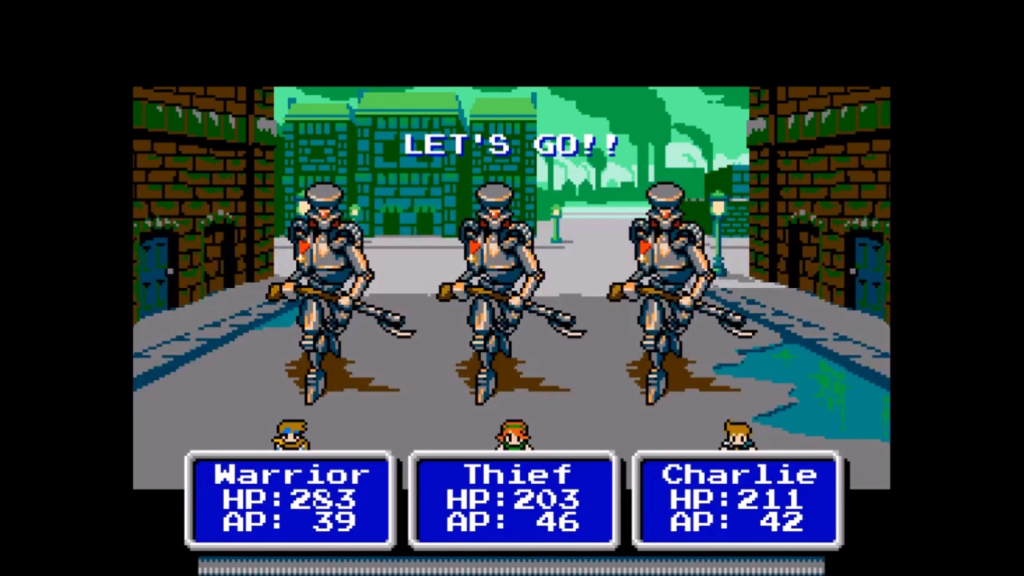
There are plenty of other points worth mentioning with this combat system as well. One of the biggest features, and one which I wish more games implemented, is the swap mechanic. Even though only three of your four party members can fight at a time, all four can participate in any given battle. During a character’s turn, they can be swapped with the fourth party member at absolutely no cost. This is a great feature for avoiding damage if a character is low on health and it can also be utilized offensively by debuffing an enemy with one character and then swapping them out for a stronger character on their next turn. Judging by the screenshots and the trailer, these aren’t the only four characters available to players and your combat options will inevitably grow alongside your total party size thanks to this mechanic.
Skills play a large role in combat. Within this demo, each character (excluding Robot) has four active abilities which cost AP, a passive skill which is always active, and a personal skill which can be used for free. Most active skills are about more than just raw damage, such as Warrior’s Rend skill, which reduces the defense of every enemy on top of dealing decent damage, and Thief’s Haste skill, which increases a party member’s agility stat for three turns. Healing for skills and consumables alike is also percentage based, which is an excellent decision as this means everything scales with you rather than clogging up menu space later on.
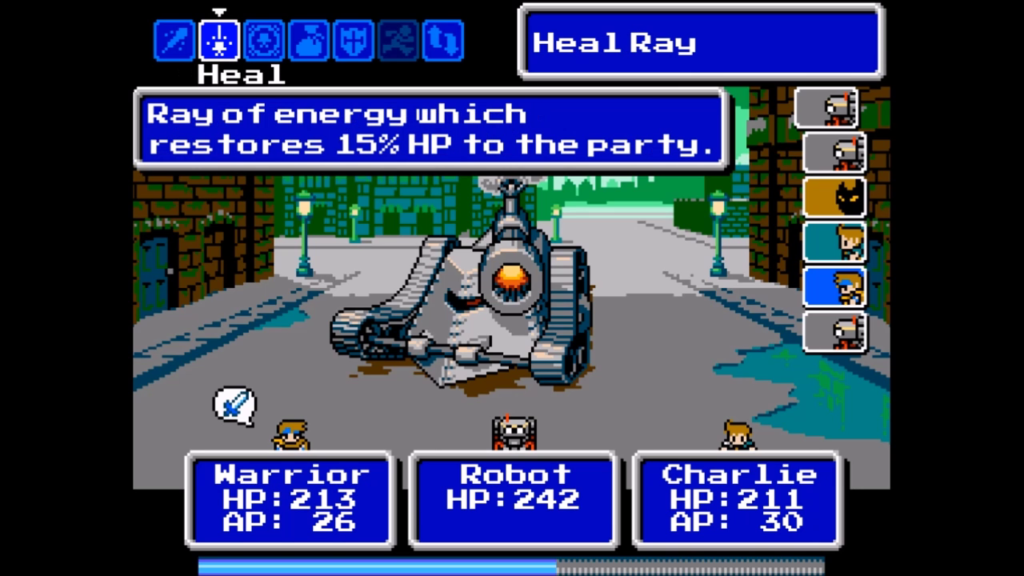
None of the three normal enemy types in the demo are particularly threatening (it’s clearly an early part of the game), but they aren’t outright pushovers either and they still employ plenty of tricks like increased physical evasion, armor break, and a charged attack so your allies aren’t the only ones tossing around support skills. With such a heavy focus on support, figuring out who you want to swap in to receive buffs or to take advantage of weakened enemies is not the only thing to consider – you need to also decide on who you’re willing to swap out as they’ll no longer be able to receive nor give support while they’re not on the front lines.
Let’s quickly go over the remaining skill types. Each character has a single personal skill which can be used at no cost. These are things like Steal for Thief and an attack with a chance to stun for Warrior which only deals damage if the stun connects. Warrior’s standard attack is also a little different as he has a weak, normal, and strong version to choose from with the weak normal attack sacrificing damage for accuracy and vice versa for the strong version. Thief’s Steal skill also has different text based on if it misses or if the enemy simply has nothing left, a small bit of polish which I definitely appreciate (it also has a pretty high success rate). These skills are generally situational in nature, but they’re all handy and serve as good alternatives to the default attack. Meanwhile, passive skills do things like give characters a chance to counter or to automatically block attacks aimed at them. You don’t have any control over passives, but they define a character’s capabilities just as much as active abilities and personal skills.
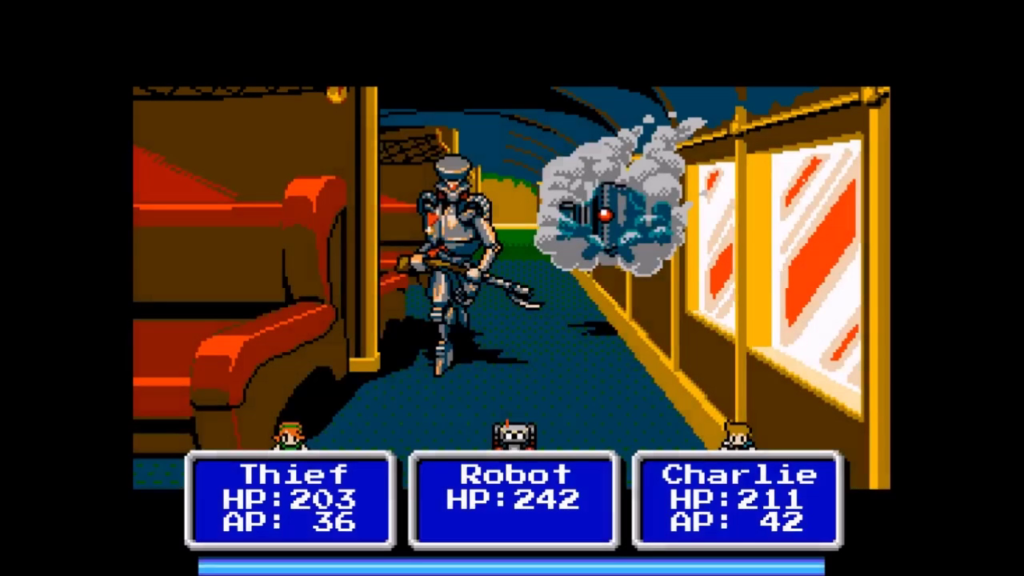
As for Robot, they have neither a default attack nor active abilities nor even a specific personal skill. Instead, Robot can equip up to three “parts” and each part grants them a different skill they can use in combat, so it’s sort of like they have three strong personal skills. Last of all, a large blue bar at the bottom of the screen fills up every time a party member gets hit. This bar carries over between fights and once its full you can use a single Omega skill. It’s basically a party-wide Limit Break system and the Omega skills vary between characters, but they generally either hit a single enemy many times or deal heavy damage to every enemy; Omega skills are fun and straightforward.
While I think this is a very strong combat system overall, there are three points of concern I want to mention before moving on, two of which are rather minor. First, the box with Omega skill descriptions covers up the arrows which normally appear above the enemies’ heads. This isn’t an issue for skills which hit everything or if you know all the enemy names, but it can be a bit cumbersome for single-target Omega attacks if you’re fighting multiple enemy types whose names you’re unfamiliar with.
Secondly, the demo ends in a boss fight which mostly feels well-balanced for an early boss, but it does like to use an attack which inflicts Confuse. A boss having this common RPG status ailment isn’t odd in and of itself, but it is strange that, to the best of my knowledge, there are no items nor abilities within the confines of the demo which can be used to snap affected party members out of it.
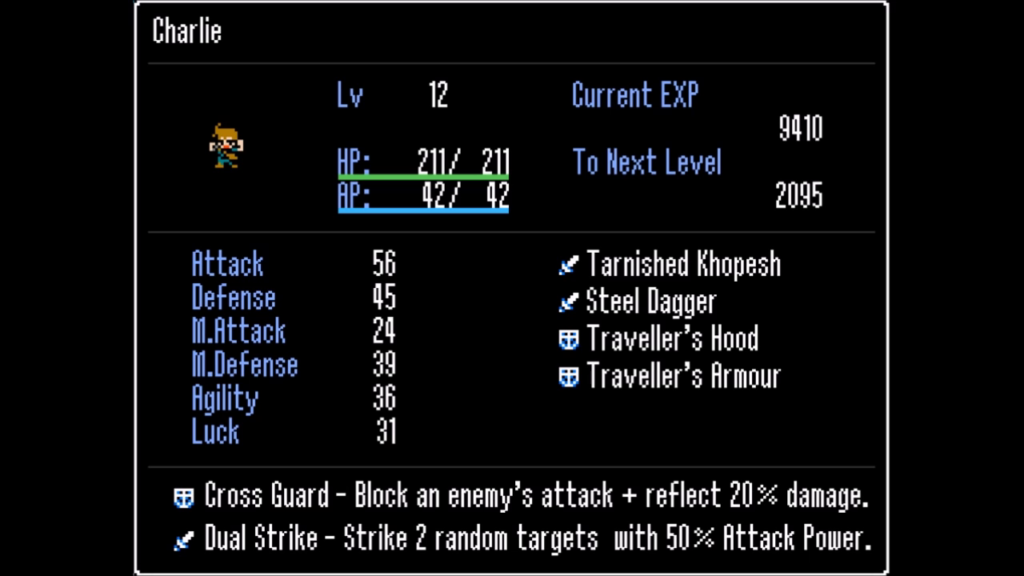
My final concern, and this is definitely the biggest one, is the existence of Charlie’s Double Slash ability. As the name implies, this allows Charlie to perform the equivalent of two normal attacks against a single enemy for the low cost of 6 AP. To put this into perspective, Charlie also has access to the Lucky Shot ability for 6 AP, which has a 50% chance to be a guaranteed critical hit and a 50% chance to miss. Landing a critical hit seems to deal about twice as much damage as a normal attack.
In other words, Charlie can choose between a guaranteed shot at dealing double damage or potentially dealing double damage with a 50% chance of missing entirely for the same fairly low cost. Double Slash already throws off the ability balance within the confines of the demo and its focus on raw power feels out of place alongside so many other utility-oriented ability. Perhaps this ability becomes less overpowered later on, but as it stands I would be happy to see it changed or even removed entirely.
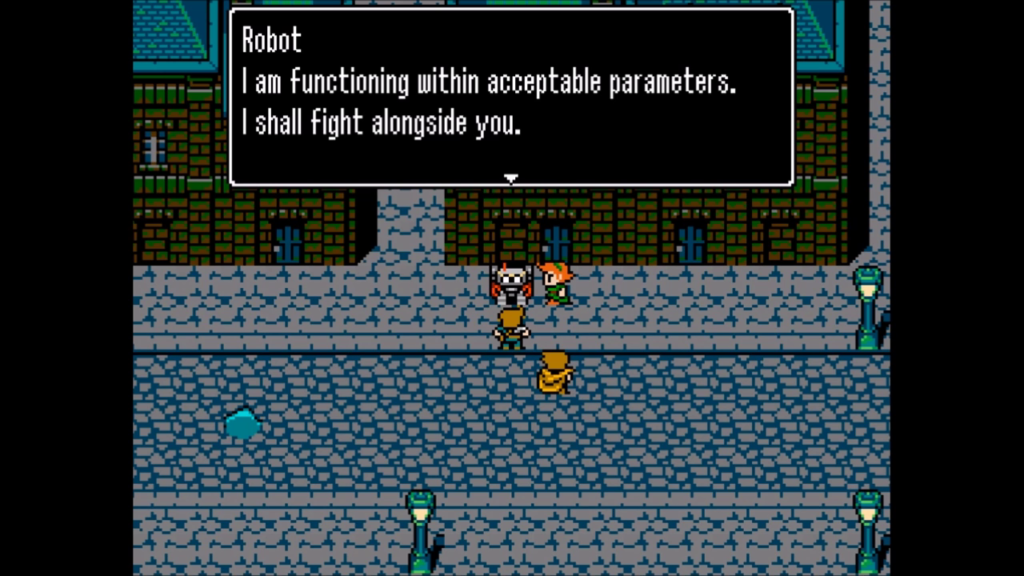
As far as the plot goes, it’s largely kept mysterious, but the demo does like to drop a few clues so let’s see what we can piece together. The most important point is that this game’s title doesn’t just refer to the aesthetics. With location names like “Processor”, an antagonist named Glitch who does indeed distort the world a bit while he’s present, and a talking save point, the setting itself looks to be the world inside an 8-bit game cartridge.
Warrior, Thief, and Mage (not playable in the demo) are all also apparently returning characters from the first game, though I haven’t played that one so I’m unsure as to how closely linked the two are. At the very least the plot of this one looks to be self-contained enough that playing the first isn’t necessary. A press release / instruction manual on the official site (found here) also gives some useful background information on the demo’s four playable characters.
Diving more into the realm of speculation, the area the demo takes place in is probably the second or third “dungeon” of the game judging by the fairly low difficulty and character levels. The area before it in the final game is also likely a desert as much of the party’s equipment references being protective wear for deserts in its flavor texts. As for the talking save point, it doesn’t play too large of a role in the demo’s plot and it certainly seems friendly, though I’m rather hesitant to trust anything with speech patterns similar to those of Undertale‘s Flowey.
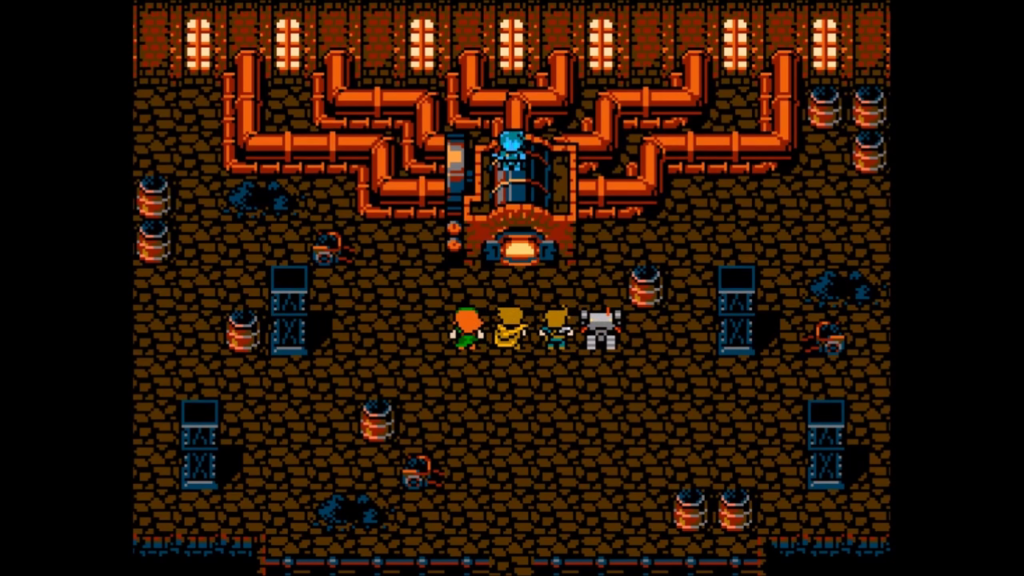
Aesthetically, this game looks and sounds great. The Steam page claims that the music is “NES-accurate” and, while I’m not familiar enough with the inner workings of the NES to know how true that statement is, it certainly seems right. More importantly, beyond any sense of nostalgia or authenticity, the music within this demo is catchy and fitting for each area or situation. I’m particularly fond of the combat music, both for normal fights and boss battles.
Graphically, 8-Bit Adventures 2 plays fast and loose with its setting. While the spritework is reminiscent of a NES game, the color palette doesn’t seem to be strictly limited to that of the NES and some of the art is probably a little more crisp and detailed than what a NES game would realistically be capable of. It’s an 8-bit game with some 16-bit flourishes and that’s not at all a knock against it, especially since the nature of the setting and what has been revealed about the plot allows for and even encourages the rules to be bent. There are also some nice extra details scattered about, such as the party leader’s hair blowing in the wind while you’re on top of a train.
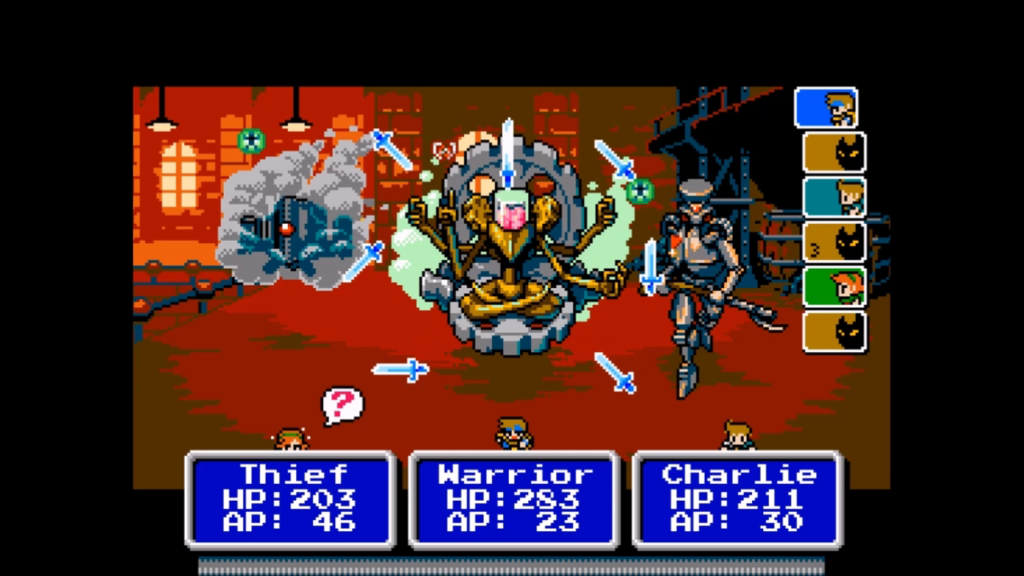
There are a few very minor issues in the demo which will more than likely be fixed for the official release. At one point an enemy ambushes you after you open a chest, but it disappears without a fight once it reaches you. I’m going to guess that this one isn’t an oversight and the fight itself is simply not implemented. On the other hand, passive personal skills like Warrior’s Counter Attack can be “used” from the skill menu outside of combat. Using these doesn’t actually do anything nor does it cost anything so this doesn’t have any sort of tangible impact upon the game and it’s a small oversight I’ve seen in many other RPG Maker games as well.
The largest of these small issues concerns item descriptions. Your party starts with three types consumable items, Potions, Ethers, and Fenix Downs. Of these, both the Ethers and especially the Fenix Downs have parts of their descriptions cut off when selecting them in combat. The text is entirely legible from the menu outside of combat and anyone slightly familiar with RPG’s can probably guess what an Ether and a Fenix Down do anyway, but this is still definitely an issue and one which could be substantially worse if it also affects any less conventional consumables. I also confirmed that the text gets cut off in both windowed and full mode so it’s not related to resolution.
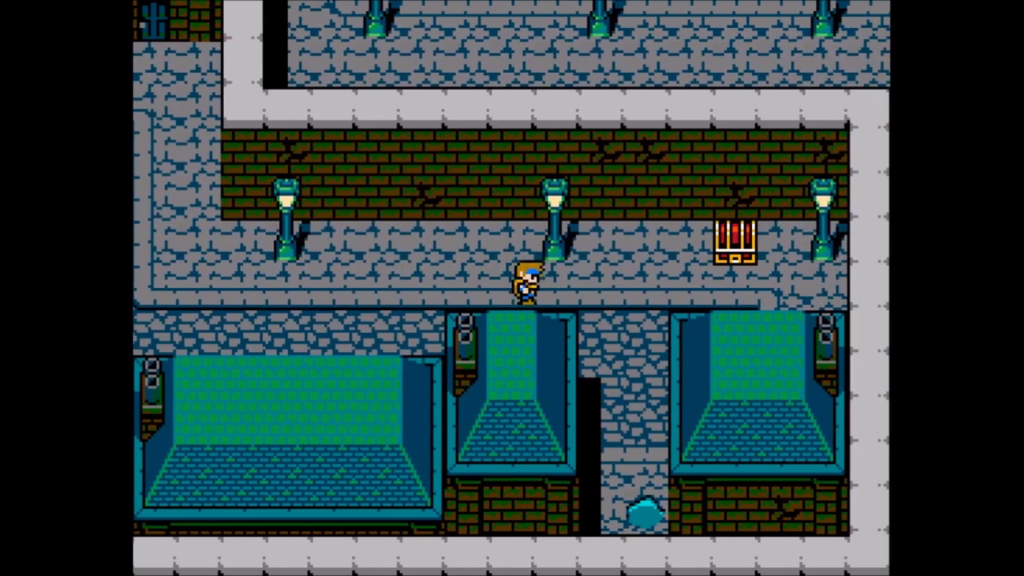
Exploration is more of a mixed bag and is the weakest part of the demo overall. To begin with, this ~45 demo is divided into three distinct parts: the city of Processor, a train ride, and a factory area called Foundry. Of these three, the train and Foundry are fine and problems only really crop up in Processor. Your movement speed is on the slow side and the random encounter rate is about standard for the genre, I ran into about one or two fights per screen transition. I would have liked to have access to a run button, though Foundry is short and compact enough that the movement speed wasn’t an issue there.
The train is more cinematic in nature and it’s my favorite part of the demo. While on the train you periodically transition between progressing inside it and ducking outside to walk across the roof. Instead of random encounters, you fight and avoid groups of clockwork soldiers on this vehicle. I especially like how the scrolling background gradually transitions from that of Processor, to a body of water, to that of Foundry each time you have to move outside. There’s even a brief non-combat encounter with the demo’s boss and the whole ride is well executed and entertaining.
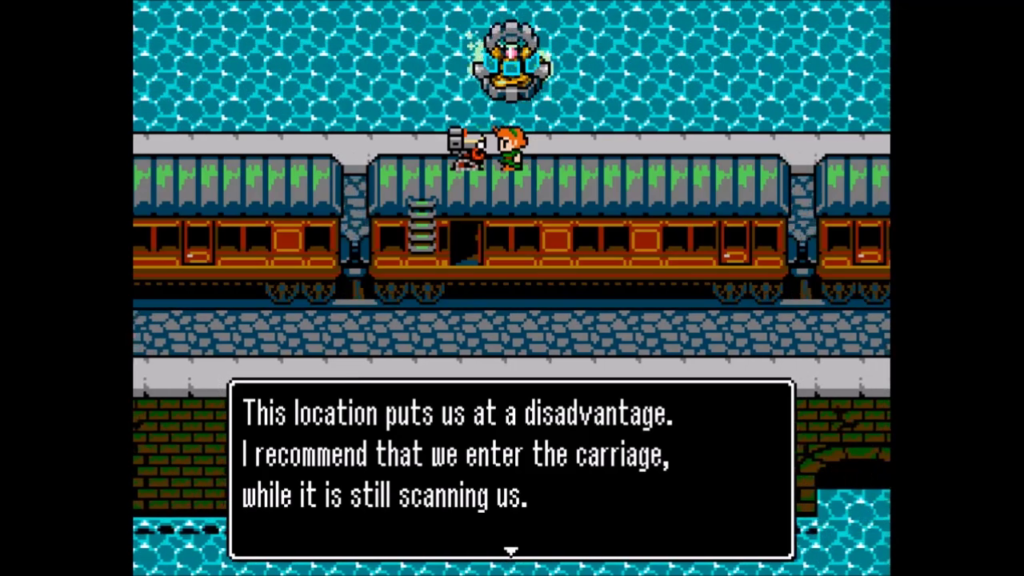
The problem with Processor is that it’s simply too big. It’s not a massive area, but it’s far larger than Foundry and the treasure is spread out, often at the end of otherwise dead end paths, so you have to do a fair amount of backtracking to collect all of it, especially if you realize that you missed a side route somewhere. There aren’t any puzzles, cutscenes, or pieces of flavor text to break things up along the way either; the winding streets of Processor feel a little dull by the time you arrive at the train. The treasure is rather useful too as there’s a new skill-granting part for Robot and various “Augments” which can be equipped by any character for powerful passives like +10% max HP so you want to collect it even if doing so starts to feel like a chore. Processor doesn’t need to be quite as short as Foundry, but it could definitely benefit from being tightened up in a few spots.

This may not be the longest of RPG demos, but it accomplishes everything a demo should. It teases plot points without completely giving them away, shows off the combat system, gives a good sense of the game’s strengths as well as a few weaknesses which could be shored up before the final release, and it made me excited to play 8-Bit Adventures 2 when it releases later this year.
Developer here =) I just wanted to give a massive thank you for the wonderfully written article (and very enjoyable playthrough too)! I sincerely appreciate you taking the time to write such an in-depth article, and just watching you play the demo was actually very helpful. I’m so glad you enjoyed it, and it was really great to get such detailed feedback from someone who obviously loves RPGs as much as I do! You noticed a lot of little things, so that was very fun for me (percentage-based healing items are the best!).
I actually left a comment on your Youtube video that answered some of the things you brought up, so I just thought I’d repeat a few of those points here for anyone who’s interested.
– There are 7 playable characters in total, so there will definitely be lots of options in regards to swapping as the game progresses.
– The Omega Burst window covering up the enemy selection arrow has been fixed since the demo came out and will not be a problem in the final game. Sorry about that!
– In the full game, you can heal the boss’ Confusion with items you buy at shops. Honestly, their lack was a complete oversight on my part; I intended to add a few of them into your inventory for the demo, but got caught up with bug fixes/dealing with other issues and simply forgot about it. Sorry (although it did make the battle more intense for a second there in your video =P)!
– You’re very right in regards to Double Slash. At one point during demo testing, it could do around 500 damage! It has a lot of modifiers to try and keep it in check, but it’s still being balanced. Critical Hits actually do a bit more than double the damage (although I can’t remember if that modifier has changed since the demo – it may have), so it is technically more powerful. But thank you for bringing that up; it’s one of a few abilities that are under a lot of scrutiny at the moment, and it’s helpful to hear an outside opinion. The main reason it’s in there is because attacking twice seemed more interesting than just ‘hitting harder’. But we’ll see how that pans out!
– 8-Bit Adventures 2 is a direct sequel to the original, taking place around 2 years later. While there are lots of references to past events in the world (and characters continue on the same trajectory of development), it’s definitely a self-contained story that I think anyone can enjoy.
– The Processor is reasonably early, but it’s not *that* early. The demo was specifically balanced to be a demo, so don’t read into that too much 😉 It’s actually the 6th dungeon in the game (so a few hours in). Off the top of my head, there are just over 25 dungeons (including optional ones), so it’s not too far into the game.
– Huh, that’s an interesting comparison with Flowey, actually – because you’re right! But Save Point’s inclusion (and use of words like ‘Howdy!’) actually predates the release of Undertale. He’s been the player’s pal since the first 8-Bit Adventures game. It’s funny how stuff like that works out. But I’ll be up front and say that you don’t have to worry about Save Point =P
– We actually do stick to the NES colour palette 99.9% of the time! There have been a few times where we’ve added an external colour to one specific asset, just to make it more discernible to players, but I could probably count them on one hand (and I don’t think any of them were in the demo). The artist, Jerram Fahey, works very hard to stay within the limitations of the art style. You’re not far off, though!
Where people get tripped up is that we’re not using the limitations of the NES. So while we use the NES colour palette and sprites were drawn at the correct sizes, we can display as many of those colours on a single screen as we want. This was technically possible on the NES if you knew how to use the system’s PPU effectively, but I believe it also impacted performance. Anyway haha – it’s similar to how Shovel Knight approached things, if you’ve played that game.
– Thank you for finding that bug where the weird robot ambushed you after getting the Industrial Goggles! You were very kind to give me the benefit of the doubt, but the truth is that that was an old placeholder (which I thought I’d removed) XD If you’d found that treasure chest while the train was still moving, it would have worked; it just hadn’t been updated on the stopped train. Anyway, this bug being caught is all because of you, so thanks again! =D
– Being able to use passive abilities in the menu is a bug that’s since been fixed. Sorry for the confusion there! Most people don’t seem to have explored the menus that thoroughly haha, but good catch!
– – …Whoops! Thanks for noticing that some of the item descriptions run a bit too long. You’re actually the first person who’s brought it up! That is now fixed =)
– Just to clarify: the encounter rate is actually set up so that you only fight one battle per screen. The only exception to this is the big second room in the Foundry where you can fight a max of two. This is an encounter rate that’s very much being tweaked, and I’m trying to figure out how to pace it correctly for each section of each dungeon.
– A lot of people have brought up the Run button, so that’s pretty much a definite change for the full game (I’m just examining how best to implement it alongside encounters at the moment). Thanks for the suggestion!
– Glad you enjoyed the train! That took a lot longer than I would have liked to develop, but it seems to have paid off =D
– You make some very good points about the Processor City. Essentially, I expected people in the demo to explore a little bit, but not too much, so they’d find one of those Max HP Augments and Robot’s Rocket Punch, and then go straight to the train. That seems to have been some peoples’ experience, but not others (as your video demonstrates). So I really appreciate the feedback, and I’ll definitely be doing some “tightening up” of this area (I have some ideas, and the Run button should help too).
Sorry to write such a long comment, but I hope that addresses some of your concerns! Thank you so much for writing the article and making the video – I sincerely enjoyed them (and appreciated the kind words/helpful feedback) and I hope to see you again when the full game is released!
~Josh Hallaran
Critical Games